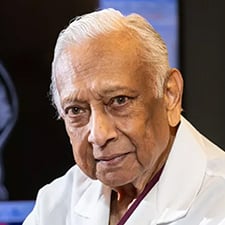They say big things move slowly.
The U.S. medical education system is a case in point. Just ask Dr. Arnold Menezes, a neurosurgeon at University of Iowa Health Care and a professor of neurosurgery at the University of Iowa Roy J. and Lucille A. Carver College of Medicine.
Back when he came to the U.S. for training in the 1960s, Dr. Menezes had graduated from one of the most prestigious medical schools in India, yet he knew he would have a hard time getting into a neurosurgery residency as an international medical graduate (IMG).
“The idea of having a new person from another country was difficult for people to accept,” Dr. Menezes said, noting that there was no matching program at that time. “It was all face-to-face, meeting people.”
A lot less was known back then
But one chance was all he needed, and he got that with University of Iowa, who wanted to create a pediatric neurosurgery program. It was something he and his wife, an anesthesiologist, had wanted to do in India. They soon realized, however, there was little infrastructure in their home country to support such a thing. Besides the shortage of treatment facilities, there were no diagnostic procedures available.
“You had to perform them yourself, and that was pretty challenging,” he said. “It would take more than half your time.”
Iowa offered him a spot in its general surgery and neurosurgery residency programs—and later, its pediatric neurosurgery fellowship program. Meanwhile, his wife was offered a spot in Iowa’s anesthesia residency program.
But this was still uncharted territory, both socially and scientifically.
“Frankly speaking, at the University of Iowa, there were no medical students, no residents, no staff from India,” Dr. Menezes said, adding that he had become particularly interested in problems at the junction of the skull and the spine.
One of those was Chiari malformation, a condition in which the skull presses on the cerebellum, causing brain tissue to extend into the spinal canal. Read more about the condition in University of Iowa Health Care’s profile of Dr. Menezes.
University of Iowa Health Care is a member of the AMA Health System Program, which provides enterprise solutions to equip leadership, physicians and care teams with resources to help drive the future of medicine.
“The outcomes were poor for patients with problems in that part of the body—30% got into trouble within the first three days—and nobody knew why,” he said. “Then all the others got into trouble slowly. Nobody had taken up this challenge of changing the pattern of mortality and morbidity that required crossing many barriers.”
Those barriers included understanding neurology, neurosurgery, orthopaedics, otolaryngology and oculoplastics.
His mentor at the time, Adolph Sahs, MD—“a giant in neurology,” according to Dr. Menezes—had noted, “Arnold, you're going into no man's land.”
Dr. Menezes replied, “Yeah, that's what it's going to take.”
It was a Herculean effort
“I had to take it all on myself, meaning see the patient, do the procedures, do the diagnostic studies,” Dr. Menezes said, adding that computed tomography (CT) left a lot to be desired when it came online in 1973. “Iowa was the third institution in the country to have it.”
Magnetic resonance imaging (MRI) arrived in 1984, and “slowly we came up with a treatment algorithm, and it was a blast, but then it became evident that we not only had to document what was going on, but we needed a database so we could go back and see what we might have missed. That treatment algorithm is still the decision tree we use to handle patients with problems in this area.”
The database Dr. Menezes built now has some 7,000 cases—he and his colleagues have identified at least 87 congenital syndromic abnormalities that affect that region of the brain—but it was started in the days long before EHRs and even before widespread use of computers. Everything was done by hand, and spreadsheets often got lost.
In addition, Dr. Menezes was contacted by neurosurgeons from across the country and even around the world. In addition to his paid workload, he would often spend an additional 20 hours per week consulting, uncompensated, on other cases.
But the payoffs did not take long to realize, he noted.
“Over time, every medical textbook would include a major chapter on the craniocervical junction,” he said. “And Iowa became known as the center of excellence for this. We were describing the problems and designing the solutions.”
In fact, they designed such effective solutions that they slashed the morbidity and mortality rate for the condition from 30% in the 1970s to just 3% today.
He’s not done yet
Dr. Menezes just turned 80, and he’s no longer performing surgeries.
“Some of my cases would take between 10 and 12 hours standing up, and I’ve had medical issues, so I don't want to take any chances,” he noted. But he still sees patients.
“I see follow-ups, I see complex problems, and if they require surgical attention, I will map out a plan and pass it on to whoever I think is most confident,” he said.
And he’s still working on his database.
“One of the editors of a major journal told me I can't retire until I get all of this material published, because nobody else has it—this is a gold standard,” he said.
But he also hasn’t forgotten where he came from, and another of his big interests is helping the younger generation of physicians, particularly IMGs seeking a foothold in the U.S.
"Most graduates who want to come to the U.S. for training in neurosurgery have to go through the Match, and most of the time they don't get into a program,” he said. “We decided we’re going to give them opportunities as preclinical fellows. They stay with us for a year minimum, and they get the exposure to neurosurgery. And if they do well, they get a good reference. Because of that, about 80% of them get into a U.S. residency program. And if they are really outstanding, we will absorb them.”
Learn more about the AMA IMG Section, which gives voice to, and advocates on, issues that affect international medical graduate physicians.
Motivation matters
IMGs are a special kind of learner, Dr. Menezes added.
“They are very productive. They've been given an opportunity and they are very grateful for it,” he said. “We open our doors to not only foreign medical graduates but also learners in medical school who aspire to go into neurosurgery. They all get to work with us.”
Fifty years after Dr. Menezes joined the university, University of Iowa Health Care is considered one of the top five academic programs in the country in the area of neurosurgery, he added. Much of that is attributable to the culture he helped create.
“We train neurosurgeons to be physician-scientists,” he said. “It’s a completely evolving situation right now, not only in terms of robotics, or computer assisted technology, which we use all the time. We have to keep up with the art and science of medicine."
That starts with meeting CME requirements, he noted, but it certainly doesn’t end there.
“They need to be reading the major neurosurgical journals, staying on top of general neurosurgery, spine neurosurgery, the child's nervous system. They also have to attend conferences to bring back things that will enhance their practices,” he said. “It requires much more than 40 to 60 hours a week.”
By “much more,” Dr. Menezes means a lifelong commitment to learning.
“I don't want to be left behind—and that's very easy to happen—so I'm always reading JAMA® and The New England Journal of Medicine,” he said. “I want to be on the cutting edge.”
The AMA provides numerous discounts and benefits to members who are fully retired. These include $84 annual membership, full access to JAMA Network®, savings on vehicle purchases and more.
Explore further with the AMA Senior Physicians Section, which gives voice to—and advocates on—issues that affect older-adult physicians, who may be working full time or part time or be retired.





